Britisch-Kolumbien |
|
|
|
| Übersicht – Contents: | |
Diese Seite ist Teil des Projektes
Britisch-Kolumbien |
|
|
|
| Übersicht – Contents: | |
Flagge – Flag: |
|
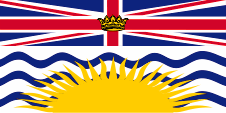 |
Provinzflagge – flag of the province, Seitenverhältnis – ratio = 1:2, Quelle/Source: Corel Draw 4   |
historische Flaggen – historical Flags: |
|
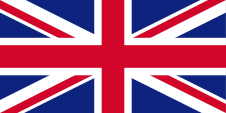 |
1827–1965, Union Flag → quasi Nationalflagge/national flag, Flagge von Großbritannien – flag of United Kingdom, Seitenverhältnis – ratio 1:2, Quelle/Source, nach/by: Wikipedia (EN), thecanadianencyclopedia.ca    |
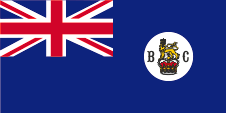 |
1866–1906, Flagge der Regierung (Staatsflagge) – flag of the government (state flag), Seitenverhältnis – ratio = 1:2, Quelle/Source nach/by: Wikipedia (EN), World Statesmen |
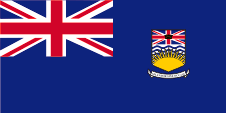 |
1906–1960, Flagge der Regierung (Staatsflagge) – flag of the government (state flag), Seitenverhältnis – ratio = 1:2, Quelle/Source, nach/by: Wikipedia (EN), World Statesmen |
Bedeutung/Ursprung der Flagge – Meaning/Origin of the Flag: |
|
| Die Flagge von Britisch-Kolumbien wurde am 27.06.1960 angenommen. Es ist eine Wappenflagge, denn sie zeigt das Design des Wappens der Provinz. Die Flagge darf von Behörden und Dienststellen der Provinz und auch von Privatpersonen verwendet werden. | The flag of British Columbia was adopet on 27th of June in 1960. It is a scutcheon flag, because it shows the design of the coat of arms of the province. The flag may be used by provincial authorities and departments and also by private individuals. |
| Bis 1922 hätte von den Dienststellen der Provinzen offiziell der britische Union Jack, die sogenannte Royal Union Flag, verwendet werden müssen, oder aber (ab 1922 im Prinzip nur noch) die kanadische blaue Dienstflagge, der typische Britische Blue Ensign, mit dem Wappenschild Kanadas im wehenden Ende. Dennoch hatten die Provinzbehörden eigene Siegel und später auch Wappen, die eigenmächtig im wehenden Ende auf der blauen Dienstflagge platziert wurden. Für dieses Verfahren hätte eine Genehmigung der britischen Behörden vorliegen müssen, was jedoch nicht der Fall war, aber toleriert wurde. Privatpersonen hatten den Union Jack zu verwenden und ab 1892 den sog. Red Ensign, die rote Version der kanadischen Flagge mit dem Union Jack in der Oberecke und dem Wappen Kanadas im wehenden Ende. | Until the
year 1922 there had officially been used, the British Union Jack, the so-called
Royal Union Flag, by the departments of the provinces, or (from 1922 nearly only) the Canadian
blue official flag, the typical British Blue Ensign, with the coat of arms of
Canada in the flying end. Nevertheless, the provincial authorities had their own seals and later also coats of arms, which were unauthorized placed in the flying end of the blue official flag. A permit should have been approved by the British authorities for this procedure, this was not the case, but was tolerated. Private individuals had to use the Union Jack and from 1892 the so-called Red Ensign, the red version of the Canadian flag with the Union Jack in the upper corner and the coat of arms of Canada in the flying end. |
| Im Zuge der allmählichen Trennung Kanadas von Großbritannien verlor der Blue Ensign als amtliches, britisches Kennzeichen seine Bedeutung und man ersetzte ihn durch neue Provinzflaggen, die von Behörden und Dienststellen der Provinzen und auch von Privatpersonen verwendet werden dürfen. So führte Britisch-Kolumbien 1960 die heutige Flagge ein. Die Flagge der Provinz folgt aus der Historie heraus britischen Vorgaben. Es gelten: Blau = Pantone 280, Rot = Pantone 186, Gelb = Pantone 116. | In
the course of the gradual separation of Canada from the United
Kingdom the Blue Ensign as an official British flag lost its
meaning and became replaced by new provincial flags, which may
be used by authorities and departments of the provinces and also
by private individuals. In this way, British Columbia introduced the current flag in 1960. The flag of the province follows British specifications due to history. They are: Blue = Pantone 280, Red = Pantone 186, Yellow = Pantone 116. |
| Quelle/Source: Volker Preuß, Flaggen Enzyklopädie, World Statesmen | |
Wappen – Coat of Arms: |
|
 |
Wappenschild von Britisch-Kolumbien – escutcheon of British Columbia, Quelle/Source: Corel Draw 4 |
Bedeutung/Ursprung des Wappens – Meaning/Origin of the Coat of Arms: |
|
| Es gibt ein reguläres Wappen für Britisch-Kolumbien, mit Postament, Schildhaltern, einer Wappenkrone und dem Motto. Hier dargestellt ist nur der zentrale Teil des Wappens, der Wappenschild. | There is a regular coat of arms for British Columbia, with a console, shield holders (supporters), withe a crest and the motto. Here is only depicted the central part of the coat of arms, the escutcheon. |
| Das Wappenschild von Britisch-Kolumbien zeigt im oberen Teil den britischen Union Jack und im unteren Teil Sonne und die Meereswellen. Sie erinnern an die Lage von Britisch-Kolumbien an der Pazifikküste, und die über dem Pazifik untergehende Sonne. | The escutcheon of British Columbia shows in the upper part the British Union Jack and in the lower part the sun and ocean's waves. They remember the situation of British Columbia on the coast of the Pacific Ocean, and the over the Pacific sinking sun. |
| Quelle/Source: Flaggen Enzyklopädie, Volker Preuß | |
Landkarte – Map: |
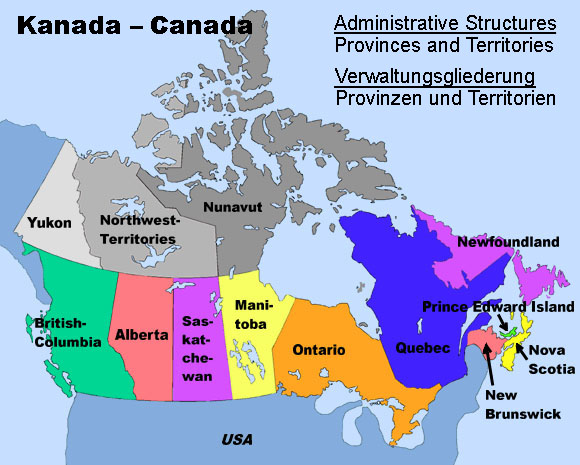 Landkarte/Map: Volker Preuß |
Zahlen und Fakten – Numbers and Facts: |
|
|
|
|
|
|
|
|
|
|
|
|
|
|
|
|
|
Geschichte: |
| 1827 · Gründung von Fort Langley als britischer Handelsstützpunkt 1846 · Grenzvertrag mit Oregon, Festlegung der südlichen Grenze auf den 49. Breitengrad, beginnende Besiedelung im heutigen Britisch-Kolumbien 1849 · Gründung der britischen Kronkolonie Vancouver auf der gleichnamigen Insel, ab 1851 mit der Hauptstadt Victoria 1858 · Gründung der britischen Kolonie Britisch-Kolumbien auf dem Festland der Westküste mit der Hauptstadt Fort Langley 1866 · Anschluss der Kronkolonie Vancouver an Britisch-Kolumbien, Hauptstadt wird jedoch Victoria 1871 · Britisch-Kolumbien wird Provinz des britischen Dominions Kanada |
History: |
| 1827 · foundation of Fort Langley as a British trade base 1846 · frontier contract with Oregon, fixing of the southern border on the 49th degree of latitude, beginning settlement in the today's British Columbia 1849 · establishment of the British crown colony of Vancouver on the same named island, since 1851 with the capital Victoria 1858 · establishment of the British colony of British Columbia on the mainland of the western coast with the capital Fort Langley 1866 · joining of the crown colony of Vancouver with British Columbia, but capital becomes Victoria 1871 · British Columbia becomes a province of the British Dominion of Canada |
| Quelle/Source: Atlas zur Geschichte, World Statesmen, Wikipedia (D), Discovery '97 |